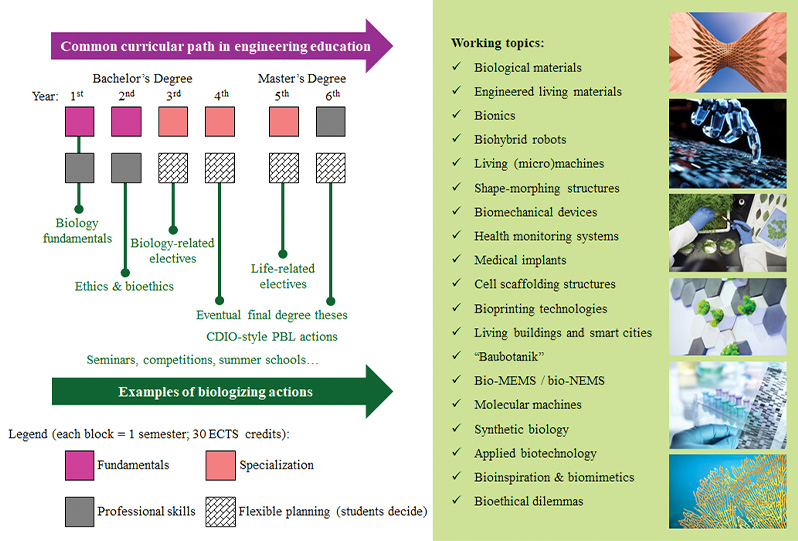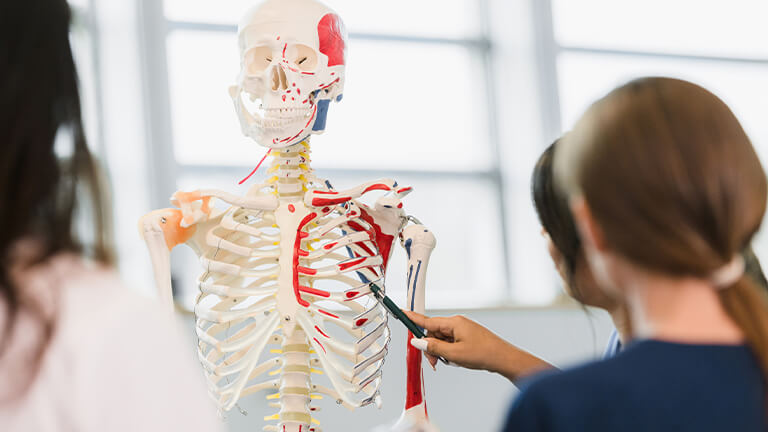Biology lies at the heart of many engineering advances. It’s time for educational programs to recognize that fact
The German language is well known for its capacity to express complex ideas and transformative processes in a single word. The German term “Biologiesierung” refers to the integration of the principles of nature and biological systems into a field of study. The term emerged in connection with economics [1] and is often translated in English as “biologization of X”—“X” being the field, in which the principles of nature are integrated. The verb “biologize” may be a better way to describe an action; “biologizing X” referring to the process, “biologized X” to the result. I use these terms here for conciseness.
Different scientific-technological fields and industrial processes are now living through biologizing processes. For instance, there have been recent strategic proposals and funding calls (especially in Germany) for biologizing materials research [2], with quite remarkable results. But this nature-inspired metamorphosis can benefit all engineering areas and especially engineering education.
Indeed, for the last few decades, we have experienced that biology and life lie at the heart of many of the most relevant engineering advances. In addition, all kinds of engineering fields can be explained through case studies and hands-on activities linked to biology. The interplay between the living and the nonliving, from smart medical devices to the emergent field of living materials [3], is leading to fascinating engineering research while simultaneously raising new ethical, legal, and social concerns.
However, the biological training of most engineers is scant and biology as a discipline is often completely absent from engineering programs at not only the bachelor’s degree but master’s and doctoral degree levels. Curiously, at least since the Renaissance, engineers have always tried to take inspiration from nature, and biomimetics is a great tool for fostering creativity. In my view, biologizing engineering education would have a catalytic effect for accelerating the pace of scientific and industrial discoveries and for helping engineers to better address life issues that could result in all kinds of technological advances.
Current examples such as electrical and electronics engineers unraveling the mysteries of the brain’s signals, mechanical engineers designing humanoid robots with enhanced biomechanical performance, architects creating self-sufficient structures and autonomous buildings capable of blending with their environments, materials and chemical engineers designing the synthetic biomaterials and cell niches of the future, or process engineers taming microorganisms in a bioreactor for recycling plastics, make a case for the central relevance of biology and life in extremely varied engineering disciplines.
Nevertheless, an understanding of biology and life processes is normally only acquired after years of struggle and professional practice attempting to decipher the secrets of biological systems. Developing a well-planned set of introductory educational programs to explore such secrets during the first inspiring years of university training, a time in which all dreams and epic quests seem possible, could be a game-changer for the engineering professional practice.
Making biology and life central to engineering education
The central purpose of this article is to propose an easy-to-implement scaffolding structure for making biology and life central to engineering education. This structure should be straightforward and cost-effective and meet the needs of both educators and students. It can be a radical change or a progressive one, but the most important thing should be getting started as soon as possible given our current environmental, health, and social challenges and the opportunity engineers hold as facilitators of solutions to complex problems.
Below, I’d like to suggest strategies to biologize engineering education in all kinds of engineering degrees. My suggestions are based on personal reflection and on selected examples of good practices (included as references), and combine a variety of educational methodologies, teaching techniques, topics, and activities. To illustrate my suggested scaffolding structure, Figure 1 includes a scheme of an engineering plan of study, based on the “Engineering Education 5.0” general scheme proposal [4], along with possible inputs for the biologizing process. Among quite direct actions, the following stand out.
- An introductory course to biology for all engineering students, lasting one semester. This course would be devoted to explaining the bridge from molecules and cells to complex engineering products, processes, and systems, and designed to help students understand the interplay between technology and life.
- Biology-related electives at bachelor’s degree level. These would involve one-semester courses on biological physics [5], ecology and environment, bioengineering, biotechnology, or introduction to synthetic biology [6], among others.
- Life-related electives at master’s degree level. These could be one-semester courses on biomechanics, biosignals, biological materials, development of medical devices, design of technologies for life, bioinspiration and biomimetics for different engineering majors (i.e., bioinspired robots, “Baubotanik” [7]), and synthetic biology, among others.
- Conceive-design-implement-operate (CDIO)-style holistic project-based learning experience [8], in which biology and life play a key role. Examples include development of medical implants; design and prototyping of health monitoring systems; conceiving and planning of living buildings and cities; and construction of innovative bioprinters or investigation of tissue engineering biomaterials and cell scaffolding structures.
- Hands-on experiences for understanding the potentials and challenges of synthetic biology. To cite a few: creativity competitions on biohybrid robots; designing living materials; prototyping shape-morphing living structures; practical summer schools on molecular machines; applied biotechnology; design of artificial cells, etc.
- Bioethics module or set of focused sessions incorporated to the compulsory course on engineering ethics and professional deontology.
- Supporting seminars, master classes, round tables, conferences, and events, including actions organized by students’ associations, with eventual recognition of credits.
- Final degree theses on any of the above presented fields or topics and many other emerging ones, and eventual research stays in departments or internships in biobased companies.
These actions, with typical recognition of 1–3 ECTS (European credits, each representing 25–30 hours of student dedication), perhaps up to 12–15 ECTS for the final theses and internships, may be integrated along the common curricular path as part of the different semesters (see Figure 1).

Figure 1. Scheme of an engineering plan of study, based on the “Engineering Education 5.0” general scheme proposal and possible inputs and topics for the biologizing process. The biologizing actions are presented linked to different blocks representing whole semesters. (Images courtesy of Microsoft Office 365 Creative Cloud Library.)
Outlook and debate
Biologizing engineering education will help students, the engineers of the future, better understand the intimate connections between engineering and biological systems. Through this understanding, engineers should be able to implement more sustainable processes, design user-centered products with enhanced ergonomics, produce improved health care technologies, reinvent materials, mechanics and manufacturing, and plan healthier buildings and cities. This will contribute to better preparedness and more rapid action against global environmental and health care concerns, which can only be successfully managed through collaborative action and a deep understanding of the biology of life. Ideally, with this educational transmutation, engineers will be ready, following equitable and sustainable principles, to foster the unprecedented technological revolutions ahead. An increased focus on ethics and bioethical dilemmas will reinforce their decision-making skills and provide them with systematic methods for wise actuations.
The proposed tasks and topics for this biologized engineering education are examples of a variety of methods and educational activities that, jointly implemented, can radically renovate an engineering degree. Each technical university, degree and educator should freely decide to what extent this process is realized in different programs, specializations, and courses. If there is agreement that these changes are useful, they can be incorporated at the pace with which students are comfortable. Possibly, the change can start with a common introductory course to biology and with an eligible set of activities and courses which could be considered teaching experiments from which both educators and students learn. Finding space for dealing with the highly relevant ethical, legal, and social aspects connected to the life-changing topics of interest for this biologizing process is also urgent and can follow previously published frameworks taken as an example [9].
Challenges ahead
Involving students will never be a problem, as they are a key driver of change in higher education and eager to see new topics emerge for revitalizing engineering degrees. Most of the outlined changes are affordable, such as running competitions on creative problem solving in connection to biological systems and related technologies, or implementing focused workshops, summer schools, or even specialization courses. It is important to consider the vast amount of open-source educational materials that can support any university in this procedure, as well as trends including do-it-yourself (DIY) biology and communities like Open SynBio, in connection with synthetic biology or Patient Innovation and UBORA, as regards shared health care solutions and open-source medical devices. Open-source hardware platforms like BITalino can also support the easy implementation of practical activities and labs on biosignals, also supported by the associated makers’ community.
For purely technical universities, one problem may be a scarcity of trained educators to teach such highly specific topics as cellular and molecular biology, genetic engineering, synthetic biology, and artificial cells. Until this issue can be addressed, technical universities in the short-term might partner with nontechnical universities or university hospitals. Incorporating multidisciplinary research projects should make engineering courses livelier and could be highly transformative.
Biologizing engineering would promote empathy for others, foster stewardship of our planet, and lead to a more ethical and sustainable engineering education. Some reluctant colleagues may argue that engineering programs are already overloaded, but in my view, it is all just a matter of will and good planning. By minimizing overlap and avoiding suboptimal educational content, we can find space for biology-grounded innovative courses, advanced research, and fruitful debate. Let’s move forward and biologize our engineering degrees.
References
- J. von Braun, “Bioeconomy: Science and technology policy to harmonize biologization of economies with food security,” in The Fight Against Hunger and Malnutrition. Oxford, U.K.: Oxford Univ. Press, 2015, doi: 10.1093/acprof:oso/9780198733201.003.0011.
- C. M. Niemeyer et al., “White paper on the biologization of materials research,” Tech. Rep., 2018, doi: 10.20944/preprints201812.0329.v1.
- P. Q. Nguyen et al., “Engineered living materials: Prospects and challenges for using biological systems to direct the assembly of smart materials,” Adv. Mater., vol. 30, no. 19, May 2018, Art. no. 1704847.
- A. D. Lantada, “Engineering education 5.0: Continuously evolving engineering education,” Int. J. Eng. Educ., vol. 36, no. 6, pp. 1814–1832, 2020.
- P. Nelson, Biological Physics Student Edition: Energy, Information, Life. Philadelphia, PA, USA: Chiliagon Science, 2020.
- G. Baldwin, Synthetic Biology—A Primer. London, U.K.: ICP, 2015.
- F. Ludwig, “Botanical basics of Baubotanik and their application to design practice,” Tech. Rep., 2012, doi: 10.18419/opus-86.
- E. F. Crawley et al., Rethinking Engineering Education: The CDIO Approach. New York, NY, USA: Springer, 2007.
- M. Ebbesen, S. Andersen, and F. S. Pedersen, “A conceptual framework for the ethics of synthetic biology,” Acad. Quart., pp. 203–223, 2015. [Online]. Available: https://doi.org/10.5278/ojs.academicquarter.v0i12.2736



